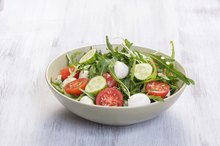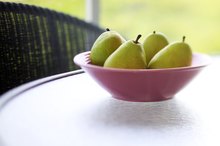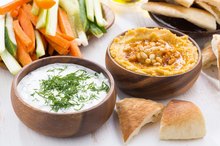Can You Eat Fruit on the Atkins Diet?
Atkins is a commercial weight-loss diet that severely restricts the amount of carbohydrates you consume. The diet regulates your intake of high-carbohydrate foods, such as fruits, and stresses the importance of specific food choices during each phase. To properly follow the diet, you need to know when you can eat certain types of fruit on Atkins.
Phase 1 Forbids Fruit
You cannot eat fruit during Phase 1, Induction. The phase allows only 20 grams of net carbohydrates per day. You can calculate grams of net carbohydrates in a serving of food by subtracting the grams of dietary fiber in that food from the total grams of carbohydrates. Vegetables should provide 12 to 15 grams of your daily net carbohydrates, leaving no room for fruit during Phase 1. This phase lasts for at least two weeks.
- You cannot eat fruit during Phase 1, Induction.
- Vegetables should provide 12 to 15 grams of your daily net carbohydrates, leaving no room for fruit during Phase 1.
Phase 2 Introduces Fruit
What Fruits Are High in Carbohydrates?
Learn More
You can enter Phase 2, Ongoing Weight Loss, after two weeks on Phase 1. During this phase, you can add certain fruits into your diet. A serving on Atkins is 1/4 cup of blueberries, raspberries, strawberries or cantaloupe or honeydew melon 14. Each serving of strawberries and raspberries contains less than 2 grams of net carbohydrates, and melon and blueberries each contain 4 grams per serving. You can also have 1/4 cup of lemon or lime juice, which contains 5 grams of net carbohydrates, during this phase.
- You can enter Phase 2, Ongoing Weight Loss, after two weeks on Phase 1.
- You can also have 1/4 cup of lemon or lime juice, which contains 5 grams of net carbohydrates, during this phase.
Phases 3 and 4 Expand Your Options
Enter Phase 3, Pre-Maintenance, when you are within 10 pounds of goal weight. You can eat all of the kinds of fruit that you had in Phase 2 and add in most other kinds gradually. A small peach, kiwi or plum, 1/4 cup of cherries or one-half of an apple or grapefruit each contains less than 10 grams of net carbohydrates. A small banana has 21 grams. Phase 4, Maintenance, begins when you reach your goal weight, and it allows these same fruits.
- Enter Phase 3, Pre-Maintenance, when you are within 10 pounds of goal weight.
- Phase 4, Maintenance, begins when you reach your goal weight, and it allows these same fruits.
Health Considerations
Carbs Allowed on the Atkins Diet
Learn More
Portion sizes are important on Atkins, so measure the amounts of fruits that you are serving yourself so that you know how many net carbohydrates you are consuming. The carbohydrates in dried fruits and fruit juices can quickly add up, so avoid them when possible to restrict your carbohydrate intake. A small box of raisins has 34 grams of total carbohydrates and 2 grams of fiber, leaving it with 32 grams of net carbohydrates. Because the Atkins diet restricts certain food groups, your diet may be lacking in specific nutrients. It can be low in dietary fiber and some vitamins and minerals, which are found in carbohydrate-containing foods like fruits, whole grains, beans and vegetables. A multivitamin may be necessary to maintain your nutrient status while following Atkins.
- Portion sizes are important on Atkins, so measure the amounts of fruits that you are serving yourself so that you know how many net carbohydrates you are consuming.
- The carbohydrates in dried fruits and fruit juices can quickly add up, so avoid them when possible to restrict your carbohydrate intake.
Related Articles
References
- Atkins.com: Phase 1
- Atkins.com: Phase 2
- Atkins.com: Phase 3
- Atkins.com: Phase 4
- USDA National Nutrient Database: Raisins, Seedless
- Low-carb diet: Can it help you lose weight? Mayo Clinic. https://www.mayoclinic.org/healthy-lifestyle/weight-loss/in-depth/low-carb-diet/art-20045831?pg=2.
- Phase One List of Acceptable Foods. Atkins. https://www.atkins.com/how-it-works/atkins-20/phase-1/low-carb-foods.
Writer Bio
Natalie Stein specializes in weight loss and sports nutrition. She is based in Los Angeles and is an assistant professor with the Program for Public Health at Michigan State University. Stein holds a master of science degree in nutrition and a master of public health degree from Michigan State University.









